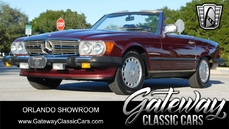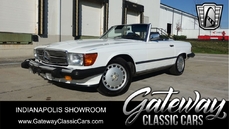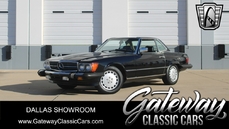Mercedes-Benz 560SL w107 5.6L V8 1989
General description :
See this 1989 Mercedes-Benz 560SL on display in our St. Louis, Missouri showroom.For sale in our St. Louis Showroom is a beautiful Garnet Red 1989 Mercedes Benz 560SL. Making its debut in 1971, the R107 body style replaced the W113, and was produced until 1989, making it the 2nd longest single series ever produced by Mercedes Benz. The R107 or SL is popularly considered one of the best looking cars Mercedes Benz produced. The 560SL was fitted with 5.6 Liter engine and is easily the most sought after of the classic SL's. Producing 238 HP, the 560SL was capable of going from 0 to 60 mph in just 7.4 seconds. A 4-speed transmission provided a smooth and more fuel efficient ride. Sitting in the beige leather seats with plenty of spring, they feel like new, and look great with minimal wear. The light-colored floorboard carpet is free from staining and looks like new as well. With lots of wood trim all around, the interior has a lot of class and is very easy on the eyes. Something as simple as closing the door with bring you joy on this 1989 560SL. When you do, you will feel how solid this car is, no rattles, just a solid door against a solid body. With the painted to match hard top to use in the fall and winter months and the dark brown soft top to protect from pop up rain showers in the spring and summer you will be covered no matter the season. The odometer reads 32,563, which represents the actual mileage on the car. Options for this 1989 Mercedes Benz 560SL include: Air Conditioning, AM/FM Radio with CD Player and Bluetooth Connectivity, Cruise Control, Manual Convertible Top (Hard and Soft Tops included), Driver Airbag, Leather Interior, Power Windows, Power Brakes, Power Steering, Radial Tires, and Aluminum/Alloy Wheels. Since 1989 this 560SL has had only 3 owners. It was bought in Florida 5 years ago and has only seen fair weather days ever since leaving the Sunshine State. This beautiful Garnet Red over light beige 89’ 560SL is ready for a new owner to enjoy and show it off with pride. To view this 1989 Mercedes Benz 560SL in greater detail, including HD pictures and an HD video, visit http://www.GatewayClassicCars.com or our St. Louis Showroom. For more information please call 618-271-3000 or email STL@GatewayClassicCars.com
http://www.gatewayclassiccars.com/STL/7703/1989-Mercedes-Benz-560SL
1989 Mercedes-Benz 560SL w107 5.6L V8 is listed sold on ClassicDigest in OFallon by Gateway Classic Cars for $34995.
Car Facts
Car type : Car Make : Mercedes-Benz Model : 560SL w107 Model Version : 5.6L V8 Engine size : 5.6 Model Year : 1989 Sub type : Convertible Location : St. Louis
Sold
Seller Information
Sold
People who viewed this Mercedes-Benz 560SL w107 also viewed similar Mercedes-Benz listed at ClassicDigest
Other cars listed for sale by this dealer
About Mercedes-Benz
In the annals of automotive history, the journey of Mercedes-Benz is a tale that unfolds with the ingenuity of its founding pioneers. In the year 1886, Karl Benz crafted the Benz Patent Motorwagen, a creation that would go down in history as the world's inaugural automobile. Unbeknownst to him, this moment marked the genesis of what would evolve into the most illustrious premium car manufacturer globally. The financial underpinning of this pioneering venture, interestingly, was provided by Karl Benz's wife, Bertha Benz, demonstrating a remarkable partnership that would set the tone for Mercedes-Benz's legacy.A parallel narrative emerged not far away, as Daimler-Motoren-Gesellschaft, founded by Gottlieb Daimler and Wilhelm Maybach, entered the scene. In 1901, they unveiled their automobile under the now-famous moniker "Mercedes," meaning "godsend" in Spanish. This name was bestowed upon the car at the behest of Emil Jellinek's daughter, the distributor for Daimler-Motoren-Gesellschaft. The wheels of innovation were set in motion.
Fast forward to 1926, a pivotal year that witnessed the merger of Daimler with Benz & Cie., culminating in the birth of Daimler-Benz. The amalgamation saw the adoption of "Mercedes-Benz" as the distinguished trademark for their automobiles, fusing the legacies of two visionary entities into one.
Contrary to perceptions of conservatism, the trajectory of Daimler-Benz unfolds as a chronicle of industry firsts. From the introduction of the honeycomb radiator to the float carburetor, and the pioneering implementation of four-wheel brakes in 1924, Daimler-Benz consistently pushed the boundaries of automotive innovation. The diesel-powered Mercedes-Benz 260 D in 1936 marked the inception of diesel engines in passenger cars. The iconic Mercedes-Benz 300SL Gullwing made history as the first car with direct fuel injection, albeit the Gutbrod's tiny 2-stroke engine can claim precedence.
Safety innovations became a hallmark, with Béla Barényi's patented safety cell design in the "Ponton"-models in 1951, featuring front and rear crumple zones. The W116 450SEL 6.9 saw the introduction of the Anti-Lock Brake system (ABS), another pioneering safety feature. From the first production airbags and beyond, the legacy of "firsts" continued to be etched into the fabric of Daimler-Benz.
Over its centennial journey, Mercedes-Benz has not merely produced cars but has sculpted automotive icons. The SSKL, 710 SSK Trossi Roadster, 770K Grosser, 540K Spezial Roadster, 300SL Gullwing, w100 600 Pullman, w111 280SE 3.5 Flachkühler, w113 230SL Pagoda, w109 300 SEL 6.3, and w201 2.3-16 Cosworth stand testament to the brand's commitment to engineering excellence.
The roaring Silver Arrows, or "Silberpfeile," including the W 25, W 125, W154, W165, and W196, created a legacy of dominance on the racetrack. These machines were not merely cars; they were expressions of precision, speed, and an indomitable spirit that left their competitors in the dust.
As Mercedes-Benz marches into the future, it does so not just as an automaker but as a custodian of a legacy, a torchbearer of innovation, and a beacon of automotive excellence. The road ahead is sure to witness the continued fusion of cutting-edge technology, timeless design, and an unwavering commitment to setting new standards in the world of automobiles.
One luminary figure who left an indelible mark was Béla Barényi, often heralded as the "father of passive safety" for his pioneering work in safety engineering. His patented safety cell design, featuring front and rear crumple zones, became a hallmark of Mercedes-Benz's commitment to occupant safety, setting new standards that reverberated throughout the automotive world.
Moving through the chronicles, the collaborative genius of Wilhelm Maybach, alongside Gottlieb Daimler, laid the foundation for Daimler-Motoren-Gesellschaft. Their innovations not only birthed the first Mercedes but established a culture of relentless pursuit of technological excellence that remains integral to Mercedes-Benz's DNA.
In the post-merger era of 1926, Ferdinand Porsche emerged as a prominent figure within Mercedes-Benz. His work on the Mercedes-Benz S-Type, a supercharged race car, garnered acclaim and set the stage for a legacy that extended far beyond the marque. Porsche's impact would later extend to his eponymous company, but his influence at Mercedes-Benz during those formative years was pivotal.
As the 20th century progressed, the legendary Rudolf Uhlenhaut emerged as a key figure. Uhlenhaut, an accomplished engineer and the driving force behind the iconic Silver Arrows, played a crucial role in Mercedes-Benz's dominance in motorsports. His engineering prowess and attention to detail were instrumental in creating some of the most formidable racing cars of the era.
In the latter half of the century, figures like Bruno Sacco, the head of design at Mercedes-Benz from 1975 to 1999, left an indelible imprint on the brand's aesthetic identity. Sacco's design philosophy, characterized by clean lines and timeless elegance, shaped iconic models like the W126 S-Class and the W201 190E, solidifying Mercedes-Benz's reputation for luxury and sophistication.
The narrative would be incomplete without acknowledging the contributions of engineers like Hans Scherenberg, whose leadership in the 1970s ushered in a new era of technological innovation at Mercedes-Benz. Scherenberg's tenure saw the development of groundbreaking technologies, including the Anti-Lock Brake system (ABS) and the introduction of airbags in production cars.












